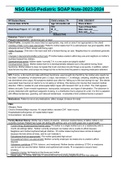Essay
Essay Unit 14 - Physiological Disorders and their Care
- Vak
- Instelling
I wrote this essay for my health and social care BTEC course at college and received a distinction*. I cover all the areas needed to achieve top grades. In my coursework, I have used Rheumatoid Arthritis & Parkinson's disease. P1, P2, P3, P4 M1, M2, M3 D1 , D2
[Meer zien]












